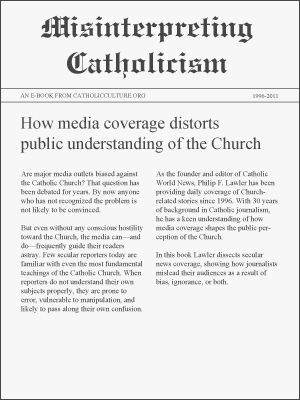Review: Coming Apart, by Charles Murray
By Phil Lawler ( bio - articles - email ) | Sep 14, 2012
No democracy is perfect. The principle of “one man, one vote” might apply to the ballot box, but it does not prevent skilled activists from amassing more power than ordinary citizens. The chief executive of a large corporation has more political clout than the night watchman; a lobbyist influences public policy more effectively than a housewife.
Most of us, most of the time, are reasonably content with these practical inequalities. We may gripe about our inability to influence policy (“You can’t fight city hall!”), but for the most part we are content to let public officials handle public affairs, while we concentrate on our own private lives.
Early in the 20th century several leading social scientists developed the theory that every society naturally produces some sort of political elite. The Italian theorists Vilfredo Pareto and Gaetano Mosca wrote that the existence of an elite is not a bad thing, provided that the elite does not become too deeply entrenched (they called for the “circulation of elites”) and ordinary people have some redress (“juridical defense”) if the elite’s exercise of power become oppressive. Such studies in “elite theory” fell out of favor among social scientists toward the end of the 20th century. But Charles Murray has kept the discussion alive with works like The Bell Curve and now Coming Apart.
In The Bell Curve, Murray and co-author Richard Herrnstein made the controversial observation that an American’s degree of success in life—his educational achievement, financial security, and even the likelihood of his involvement in criminal activity—can be largely predicted by his native intelligence. They also noticed that in American society, the brightest (and therefore most successful) individuals were becoming increasingly isolated from the least talented and neediest members of society.
Now, nearly 20 years later, in Coming Apart Murray announces that his social stratification has reached dangerous levels. Bright, wealthy, talented individuals are more and more likely to live in pleasant, roomy suburban communities, while those less fortunate cluster in blighted urban areas. A distinct class structure has emerged, and the privileged rarely interact with the needy.
Murray bases his work on the extensive study of American neighborhoods done by both social-science researchers. He finds that some communities (he calls them “SuperZips” because their zip codes are well known to marketing experts) are now exclusive enclaves for the affluent and well-educated. The residents of these communities are likely to send their children to elite schools, where they will meet and marry the products of other “SuperZip” communities.
Life is good in the SuperZips, and not only because they are affluent. Crime rates and divorce rates are much lower than in other American communities, and especially in comparison with impoverished communities. Murray argues that the simple human virtues that sustain healthy community life--industry, honesty, fidelity, and piety—are successfully instilled in the children of the SuperZips, but not in the depressed communities.
The most important measure of a community’s health, Murray argues, is the rate of intact marriage—or to be more precise, the percentage of children raised in intact homes. Study after study has shown that children raised by their parents, living together, are much more likely to prosper in school and at work, much less likely to become involved with drugs or crime, much more likely to raise happy families themselves when they enter adulthood. Murray underlines the importance of these studies, and wonders aloud why pundits and politicians do not take notice of them:
I know of no other set of important findings that are as broadly accepted by social scientists who follow the technical literature, liberal as well as conservative, and yet are so resolutely ignored by network news programs, editorial writers for the major newspapers, and politicians of both major political parties.
For decades, American social scientists have debated about the influence of race on family structure. To escape from that argument and concentrate instead on his own thesis, Murray narrows his focus to white families and white neighborhoods. In the most intriguing and perceptive part of this book, he provides a detailed analysis of two representative white communities: Belmont, Massachusetts, a “SuperZip” suburb of Boston, and Fishtown, a working-class neighborhood in Philadelphia.
The picture that emerges from this comparison is striking. When asked if they are happily married, more than 60% of Belmont’s married residents reply in the affirmative, and that number is rising over time; in Fishtown the figure is below 30%, and falling. In Belmont less than 5% of the adult male population is not earning a living; in Fishtown it is 30%. In Belmont fewer than 5% of the households with children are headed by single mothers; in Fishtown the figure is 20%. But now notice a troubling omen: that figure—the uber-measure of societal dysfunction—is rising in both Belmont and Fishtown.
Murray makes a powerful argument that while the residents of Belmont enjoy unprecedented prosperity, those of Fishtown are falling into a cycle of poverty and social pathology that could last for generations. The virtues that could enable young people to escape from the underclass—the value of education, self-sacrifice, hard work, self-reliance, and deferred gratification—are not being taught to the children of Fishtown. The successful Americans who could be models for the emulation of Fishtown’s youngsters are almost literally invisible to them, behind the graveled driveways and manicured lawns of Belmont. Murray’s vision of America is a deeply troubling one, in which the most fortunate do not feel responsible for the least fortunate, and the least fortunate do not even feel responsible for themselves. So the rich get richer and the poor get poorer at an accelerating rate.
Is there a solution to this unhealthy stratification? Murray looks back to a happier time when the wealthiest man in town might have lived in the largest house, but he still lived in the same town as working-class people. Wealthy people had working-class friends; professors had blue-collar neighbors. They understood each other, cooperated with each other, helped each other. “The first unparalleled aspect of American community life was the extent of neighborliness,” Murray observes. That neighborliness is defeated by the flight of the rich and talented to the SuperZip suburbs.
In one of the few optimistic notes in Coming Apart, Murray remarks that military service has always been an effective way of bringing young men from different social backgrounds together in close harmony, and today upper-class Americans are far more likely to enlist in the military than they were in the era of the Vietnam war. That could be a small step in the right direction. But there are danger signs, too. The rise in out-of-wedlock births, even among the children of the SuperZip neighborhoods, could be a sign that the virtues that made American affluence possible have been eroded even in the neighborhoods where that affluence is most evident.
In any case Coming Apart is an important book, well worth the time of any reader interested in taking a hard look at the centrifugal forces that undermine American society.
All comments are moderated. To lighten our editing burden, only current donors are allowed to Sound Off. If you are a current donor, log in to see the comment form; otherwise please support our work, and Sound Off!
-
Posted by: chris6730 -
Sep. 18, 2012 9:47 PM ET USA
It's a troubling trend, of which the better cure is conversion. Murray points out that historically the US was founded on the sort of liberty that can only be sustained by a virtuous society. Absent that virtue, this country must adopt a more coercive government, or perish. The ideologies of conservatism and liberalism are both right: they only differ in assessing the amount of society's virtue, and consequently the need for government coercion.
-
Posted by: FredC -
Sep. 18, 2012 4:51 PM ET USA
Is there a correlation, over time, in these two towns between religious practice and societal dysfunction? Is there a correlation, over time, between government welfare and societal dysfunction? In my youth, wealthier people helped poorer people directly. Now wealthier people pay taxes that are distributed to the poorer. The wealthy no longer grow in the virtue of charity or feel a responsibility toward the poor. Meanwhile, the poor no longer feel an obligation to unburden the wealthy.








